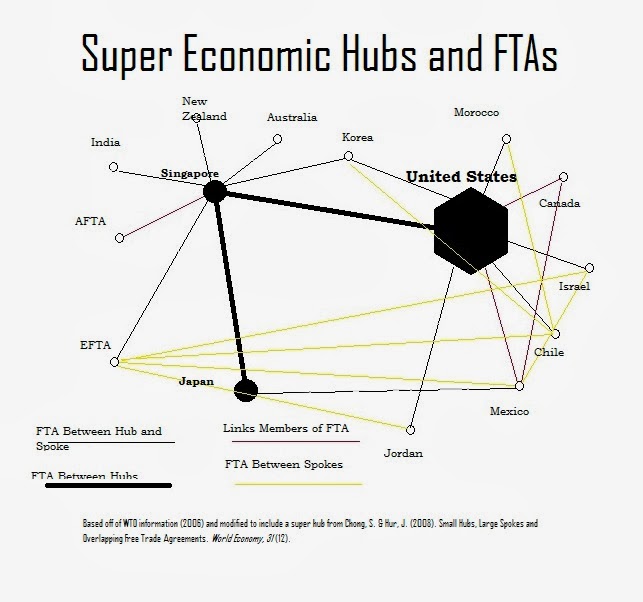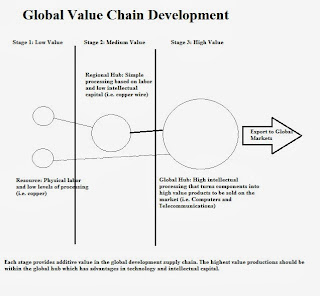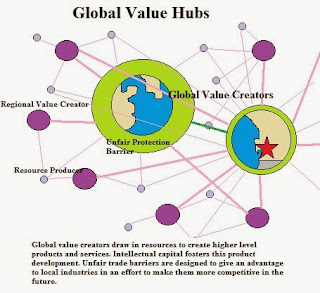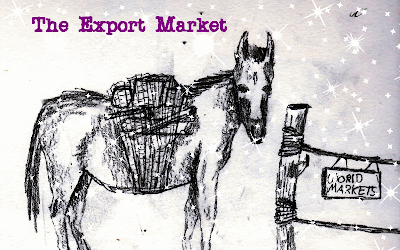Economic development is a major concern for regions
and nations. Having a model to map how Free Trade Agreements work together is
important for creating better policy. The authors Chong & Hur (2006)
discuss how hub and spoke models can be used to see these relationships. They
furthermore move into who receives the greatest economic advantage in such
models under certain conditions. The information can be added into existing
research on the dynamic value creation that occurs within economic hubs.
The far majority of regional trade agreements (RTA)
are actually Free Trade Agreements (FTA) whereby tariffs, restrictions, quotas,
and preferences on many of the products exchanged between two countries. When
two countries seek to enhance their economic strength by mutually working
together they may sign FTA agreements based on finding a chain of production.
This may require the updating of technology to ensure that products are tracked.
The hub and spoke model (HAS) allows for a greater
analysis of the benefit or detractors of overlaying agreements. Previous models
analyzed economic impacts of single agreements. A HAS can allow for the
analysis of greater amounts of agreements to determine if they have a benefit
for a region or country. It allows the mapping of overall agreements and the
totality of their benefits.
In general, being the hub allows an area to be the
center of international activity for all of the spokes. The spokes have access
to the hub and the hub has access to the spokes. Reduction of costs for
importing and exporting reduces the cost of the product and improves upon
exportation of products.
A super hub is a location that is the center of many
different hubs and spokes throughout the global economy. Products, wealth, and
opportunities are at their greatest within a super hub. As countries connect to
hubs to create their own framework and these hubs connect to super hubs the
system becomes interconnected. Those at the center of the hubs create greater opportunities
and investment due to duty-free access of all participating members (Wonnacott,
1996).
In order for hubs and spokes to work at a maximum level
that raises economic output they will need to reduce trade transaction costs. Agreements that encourage a level of
integration include intellectual property protection, foreign investment,
competition policies, dispute settlements, telecommunications, and
environmental protections. Criteria are defined for each of the agreements and
have hidden costs and benefits that make themselves known over time. Generally,
the more integrative the less the cost and greater the benefits.
When conditions are imperfect conditions across the
globe there is a loss of trade but super hubs and hubs have less loss than others.
This may be manipulation of currency, high import tariffs, corporate espionage,
corruption, and many other factors that give one country an unfair advantage
over others. This encourages a warped or manipulated system that impacts other
transactional costs and relationships among competing countries.
The authors found that strong emerging economies
prefer hub status over a simple trade zones due to inherent economic benefits.
They will not stop with one free trade agreement and are likely to make many
overlapping FTAs to create a hub based upon their competitive strengths. They seek to integrate the interactions of
their economies with others even though there may be temporary adjustments and
labor shifts.
Comment:
The authors define a super hub as a central connected location of two or more
pairs of countries with FTAs. However, the world is a little more complex and most
countries are economically connected. A super hub is a place where the greatest
creativity, investment, value creation, and movement of products occurs. Some
of these products will come in, be adjusted, and exported while others are
organically developed. The super hub has super connectivity to other hub
locations that connect to smaller suppliers. In other words, they have the
greatest amount of sales ability to move products throughout the world due to
the overlapping economies, strategic plan, and well-designed FTAs. Their skills, infrastructure, investments, and
technology make them a place of heightened trade and ecological livability.
Chong, S. & Hur, J. (2008). Small Hubs, Large
Spokes and Overlapping Free Trade Agreements. World Economy, 31 (12).
Wonnacott, R. J. (1996). Canadian Trade Policy: The
GATT’s 1995 Review’, in S. Arndt and C. Milner (eds.), The World Economy –
Global Trade Policy 1996(Oxford: Blackwell Publishers), 67–80.



